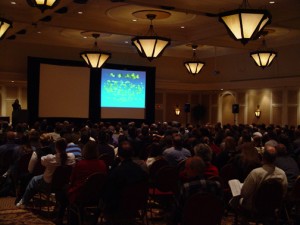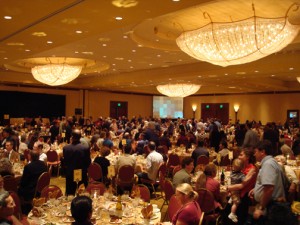I have been very fortunate over the years to have attended many professional meetings across several disciplines, and have learned some tricks over the years for successful meeting attendance. If you are thinking about attending your first meeting hopefully some of these insights will make your meeting experience more productive.
How do you find out about meetings?
If you are student starting a new career path, find out what the professional organizations are for your subject. Join the organization(s) as soon as you can, even as a student. Organizations usually have reduced student dues. It is never too early to begin participating in the field. Almost all organizations have a regular meeting. Some organizations are so large they may have sectional meetings as well as an annual meeting. The sectional meetings might be for a region of the country.
It is very common for the organization to have a special early registration rate, and you can save a little money if you are able to preregister. This allows the planners of the meeting to know how many people to expect, and to get accurate counts for any corporate catering needs. This is one of the hardest areas for planners to project as they don’t want to spend too much money on food, but they don’t want a riot of participants when they run out of coffee and donuts. It does not matter which profession it is, people get hostile when they run out of coffee!
Travel arrangements
Meetings are almost always somewhere else, which is one of their charms—being able to go to a new city, or at least getting out of town. But it does mean you will need to make travel arrangements, and of course the earlier you can do so the better.
Flying is common. If you have not flown recently, be aware that increased security restrictions have changed the experience forever. Also, airlines are now charging you for everything, including having checked and carryon baggage. Don’t forget to include these miscellaneous fees in your budget planning.
There are also some tricks to being prepared for the security screening. Check the restrictions on what you can have in your carryon, and of course avoid anything that will cause them to hold you up. If you take your computer, be sure to pack it at the top of your carryon stuff so you can pull it right out for the screening. Wear slip-on shoes if you can, or at least ones that are easy to tie. Do not have anything in your pockets. Put your cell phone and pocket change in a pocket of your carryon bag so you don’t have to mess with it at screening. Don’t wear a belt if possible, or put it in your carryon and put it on after the screening process. These simple things will help you waltz through the screening with minimal hassle.
Don’t be afraid to check your bags. Despite the horror stories you hear, most baggage handling systems are really amazingly good, and having flown a lot I have rarely had an issue with delayed baggage. Besides, when the bag is delayed, the airline will usually have it delivered to your hotel, so you are typically only inconvenienced for a day or so. Do carry on essential prescriptions and contact supplies or other things you really cannot do without. Being flexible and congenial during unexpected travel snafus will make the experience better for you and everyone else.
However, and this is a big red HOWEVER, if you are presenting at the conference, do not put your presentation in your checked luggage. More than once at a meeting I have seen some poor soul have to stand up and instead of presenting their latest and greatest bit of wisdom, have to say they lost the presentation en route. Not good.
An oral presentation today usually involves a PowerPoint show. This is easy enough to carry on your computer or a memory stick in your carryon. Most poster presentations today are printed out on a large format printer on one of more large sheets of paper. Place them in a cardboard tube and carry it on with you. Even folding it if necessary is better than not having it when you need it. I have also seen people design their poster layout using multiple sheets of regular typing paper arranged in a patch-work style. This way they just carry the ten pages they need for their presentation in a simple folder.
Lodging

Happy geeks at a professional meeting
The meeting will likely be at a large conference hotel, and often there is some special rate for attendees at the hotel. Sometimes the organizers will also contact several motels in the area and arrange special rates with them too. My strong advice—stay in the conference hotel. It is often a bit more expensive, but I have found for the convenience it is almost always worth it. It is so nice to be able to pop up to your room if you need to during the day, or to just wake and go to the first session without hassling with fighting morning traffic and parking. It is very common to share a room with a friend, which helps keep the cost down, and if you are willing, you can get a lot of students in one room. Make reservations early as the conference hotel often fills up first.
What to wear
This varies a great deal by profession so you have to know your own field. In general, wear things that are as comfortable as possible. Do you need a dress suit or can you get by with jeans and a t-shirt? I usually see both at any given meeting. Personally, I take “business casual” clothes that are easy to pack. I may pack a tie for the banquet dinner, maybe a sport coat, but less is more, so don’t overdo it.
One nice thing about a sport coat or a sweater is that often the meeting rooms are super-chilled with air conditioning, so having a few things to layer can make you more comfortable.
Most important is to have comfortable shoes. Leave the dress shoes at home, or plan only to wear them for the more formal events. Most of the days are spent walking around the vast conference center, and most evenings are spent standing around talking. Your feet will take a beating, so come prepared.
Registration
When you arrive at the meeting venue, look for the registration tables. Meeting organizers will have a place for attendees to check in and pick up meeting materials. Usually you will get a name tag that marks you as an attendee, maybe some meal tickets, information about the community and area attractions, and a conference schedule and map. Become familiar with this information as soon as you can.
Sessions

Typical presentation set up.
Most meetings have sessions, both oral and poster. There will likely be concurrent sessions, that is, talks given at the same time in several rooms. The organizers will try and group similar talks into blocks so if there is a topic you particularly want to learn about the talks are all in one place. However, depending upon your interests, you likely will have to move from room to room between talks to catch what you want to see. I like to find the rooms where the sessions will be held as early as I can so I can begin to learn how to move between them. At first it may seem awkward, but before long you will know the conference center well.
As stated, the oral presentations are almost always PowerPoint these days. Larger rooms may have two projector systems set up at different front corners of the room, both showing the same images so you can see from more places in the room. I like to try and sit on the side with the speaker’s podium. Almost always when they speak they make reference to the slides with a laser pointer and so being able to see where they are pointing on the screen can make that easier.
I like to sit as far up front as I can. It is easier to see. However, do think about your “plan of attack” a bit and be considerate of other attendees. If you are just coming into a room with sessions going on, or you know that after this talk you are going to go to another session, sit where you will disturb fewer people. People do come and go all the time and that is OK. Also for this reason I like to sit on the end of a row if possible. It makes leaving easier and more discrete.
If the meeting is well run the session leaders will work hard to keep to the schedule. Usually talks are in 15 minute blocks, and to keep the multiple sessions in sync is difficult. Speakers who are allowed to go over time throw off that session’s timing, and it can be frustrating to attendees who are trying to move between sessions.
This is an important note for speakers too. If you are giving a presentation, work hard ahead of time to fit it into the time slot. It can be very difficult to convey all you want to talk about in such a limited time, but it does not look good for you when the session moderator tells you your time is up and you are not all the way through. Plan ahead and practice your talk several times to get the timing down. A rule of thumb is that you can usually cover about one slide of information in a minute, so for a ten minute talk with five minutes of questions (a typical format) you can only get in about 10-15 slides max. Practice.
Poster sessions are becoming more and more popular at larger meetings. There are only so many speaking slots available in any given meeting, so presenting information in a poster session is a way of fitting in many more presentations. There is often a designated time to view posters and for the authors to be present. Look at the schedule of presentations and earmark those you really want to see ahead of time. An added advantage of the poster session is the author is present for you to informally visit with. This allows for a one-on-one exchange of information that you do not get in the oral presentations.
Also, if you are presenting a poster, bring along a small package of push pins, Velcro stick-on tabs, markers, note cards, masking and scotch tape, and similar items. You are often not really sure when you go to hang your poster what you will need. Sometimes the organizers have been very thorough and provide you everything, but more than once I have shown up and not been able to hang a poster on the wall. Being prepared will save you, and frequently other poster presenters around you, and make your set up a snap.
After you have seen those posters you have targeted to see, don’t forget to wander around the others. Not infrequently, the posters I thought I really wanted to see are a bit disappointing, but a title that I thought would be uninteresting turns out to be amazing. Be open to these kinds of experiences.
Also study the various poster presentations for effectiveness for planning your own future posters. My suggestions are to keep your design simple. It is easy, and tempting, with easy-to-use software to “over design” your poster and make it so cluttered with information and graphics that it is hard to follow. A large part of making a good presentation is knowing how to communicate in a graphic medium, so you might even refer to books on graphic design guidelines. Provide clear section headings in a logical sequence. Make sure to use large fonts for easy readability. As a rule, do not make a “textbook on the wall” by making a lot of long text blocks. Most will never read it. Pictures, graphs, and charts tell your story much better generally. Plus, you will be there to help provide commentary when needed, so keep that in mind.
Vendors
Often a highlight of the meeting is the vendors. Conference organizers will invite companies that provide services to the profession to set up display booths and sell their materials. Sometimes there are conference specials so you can get supplies at a discount. Books are a weakness of mine, and publishers come out in force to professional meetings. It is another good reason for packing light at home, because you will be bringing more back with you than you left with!
Social events

Banquet at a typical professional meeting
Conference organizers will likely plan some kind of social event for most evenings of the conference. Frequently there is some sort of snack food there, chips and cheese maybe, and drinks. Most often it is a pay-as-you-go bar, but you may have been provided with drinks tickets as part of your registration. Sometimes soft drinks are free, so just read your conference materials to see what the arrangements are. Frequently the snacks provided are not really enough for a meal, so you may need to hit a downtown restaurant with friends too. I personally really enjoy trying new foods and take in unusual restaurants whenever I can.
These social events are often the most important part of the conference. They are a time for you to catch up with old friends, to meet new ones, and to really talk with your colleagues about trends in your profession. Plan to go to all of them. Remember however to pace yourself. It will be very fun to stay up late tonight, but there are more sessions tomorrow morning. You will have spent a lot of money to come, you want to make the most of it, and you know your body and its resting needs best, so plan your resting times accordingly.
Budget
How much will going to a meeting cost? This is of course not a simple question to answer as tastes in travel, dining style, and purchases of professional materials, all varies by person. Do you like to travel comfortably or are you satisfied with cut-rate?
For a professional attendee traveling to a conference alone, a typical budget for a five-day conference might look like this:
Travel: $600 for airfare
Lodging: $350 for 5 days if room is split with a roommate. Double cost if rooming alone
Food: $180
Registration: $300
Other: $300 Might include ground transportation, books, conference t-shirts, etc.
In my experience, it costs approximately $1,000-$1,700 to attend. You can go less expensively, if you pile a lot of students in a van, pay student registration, and squeeze them into a cheap motel, for example, but this is a good round estimate.
I have never regretted going to a professional meeting. I always return tired, but with a renewed excitement about my profession. I am always inspired by my colleagues and frequently have new ideas I am eager to apply. The challenge is maintaining that momentum when you do come “back to reality” and face the day-to-day tasks again. It can be a good idea to keep a journal of your meeting experience to review when you get home, to help remind you of the excitement you felt with new ideas. Hopefully, that is enough to carry you forward for another year, when you can turn around and do it all again.


